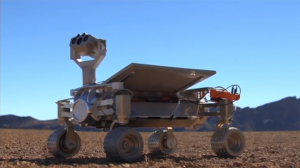 SEPT. 1 (Reuters) — German scientists want to prove that space travel needn’t cost the earth — as they prepare to send a home-made rover to the moon.
SEPT. 1 (Reuters) — German scientists want to prove that space travel needn’t cost the earth — as they prepare to send a home-made rover to the moon.
The challenge is to place the robot on the moon’s surface and explore at least 500 meters while transmitting high-definition video and images back to Earth, and all of that at a limited cost of 30 million dollars — a snip compared to the cheapest NASA mission so far which cost 250 million dollars.
The vehicle, designed by technology company Part Time Scientists, has an adjustable solar panel which captures sunlight and directs it to a lithium-ion battery.
That feeds four electric wheel hub motors that allow it to reach a maximum speed of 3.6 km/h.
The robot also has a head at the front that carries two stereoscopic cameras, as well as a scientific camera to examine materials.
It was created to compete for the Google Lunar XPRIZE, a competition that challenges engineers and entrepreneurs from around the world to develop low-cost methods of robotic space exploration.
Robert Boehme, CEO and founder of Part Time Scientists, started a team in 2008 that has grown into 35 German and Austrian engineers. They are the only German team competing for the prize, alongside 14 other finalists.
Boehme, who is convinced that their rover will make it to space in 2017, explained how difficult it had been to lower the costs down to the required 30 million dollars.
“What we wanted to try to do was to make as much as high tech as you would call available for space applications, so that you have more possessing power for less energy. In addition, number one constraint in space. So that really cuts down to our mission costs,” he told Reuters at their headquarters in Berlin.
“The goal that we have is to have a slimmed down miniaturized mission profile and that all fits into a satellite class launch vehicle. So in the end, the entire mission should cost less than 30 million euro,” he added.
The rover will be launched on board a rocket and will travel more than 380,000 kilometers to the moon.
The trip is expected to take about five days, and the team aims to land it north of the moon’s equator, near the 1972 landing site of the Apollo 17, NASA’s last manned mission to the moon. Temperatures fluctuate there by up to 300 degrees Celsius.
But Boehmer admitted there were still risks ahead, as unexpected problems related to non-space technology could still show up.
“It will definitely be crazy till the point that you can prove that it is possible. It is a really challenging goal that we set us,” Boehmer said.
“We are using a lot of components which come from a highly commercialized sector already, so the satellite industry is, you know, very well utilized in part of the space industry, so the costs are quite cut down already. Using technology which is kind of not intended to send something to the moon is always very risky, so we have to really slim down everything so that it fits into a less than 4 tonnes payload vehicle,” he added.
“From an electronic point of view, you have to limit the choice of components because not all components work as well in space as they do on Earth. For instance, the particles of the Sun can cause some damage and that can result in some things not working. But in principle you can use the same electronic pieces that are used in normal mobile phones and operate them on the moon, but not for that long or there is a chance of it malfunctioning,” the head of electronics at Part Time Scientists, Karsten Becker, explained.
Other competition participants are from Brazil, Canada, Chile, Hungary, Japan, Israel, Italy, Malaysia and the United States.
They now have six months left to secure a contract for their launch into space.







